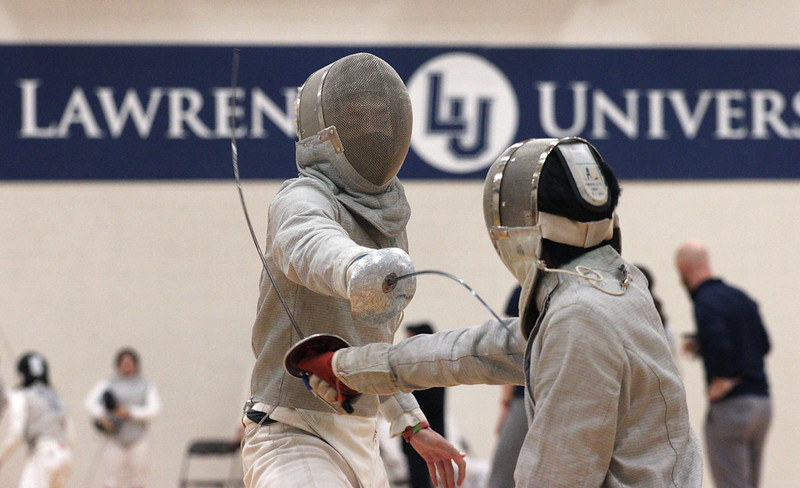The opinions expressed in The Lawrentian are those of the students, faculty and community members who wrote them. The Lawrentian does not endorse any opinions piece except for the staff editorial, which represents a majority of the editorial board. The Lawrentian welcomes everyone to submit their own opinions. For the full editorial policy and parameters for submitting articles, please refer to the about section.
Lawrence University has many gifts: a successful music conservatory, a passion for academics, a diverse assortment of engaging clubs and more. It also has a new world-class fencing coach with a desire to absolutely conquer the fencing world through this institution. With Eric Momberg’s arrival on campus a couple of years ago and a fresh batch of passionate recruits following his leadership, the Lawrence community hasn’t been able to resist hearing about the fencing team; few are immune to the allure of flashing swords. The fencing team is a small but mighty group of athletes who know that victory is entirely within reach with the right training. With the Lawrence Men’s Saber squad winning first and the Lawrence Men’s Fencing team winning third overall in Conference—not to mention the names from Lawrence who won All-Conference and All-Regional titles in fencing—we know that the fencing community is learning our names. But what about the rest of the world?
I have been peer-pressuring my friends and family to engage with fencing since I was eight years old, but it was not until I was old enough to understand the vast intricacies of the fencing community that I realized what a deeply overlooked gem it is. Because of how small the community is, there is a deep sense of connectedness within it. I have been fencing with a very similar group of girls from all over the country since I was about 12. I have seen some of those girls win national medals, international medals, and sometimes reach celebrity status where even the major fencing organization wishes them a happy birthday on Instagram. I have sat across the strip from actual world champions at NCAA events. That is not a testament to my own skill, but rather a comment on how close every single part of the fencing community is. Unfortunately, this means that if you’re on the outside of this community, you can go your entire life without hearing a peep about the vast, complex world inside. I’m not here to explain the rules of fencing; there are plenty of well-worded articles online explaining the three weapons and their differences. Instead, I am here to tell you what beautiful things there are to pay attention to within the world of fencing.
Firstly, I’d like to establish that fencing relies mainly on strategic decision-making and built-up muscle memory. While it is possible to do well without lots of physical training, it is an intense sport. It is not intense in the way that golf is, with attention to skill, nor in the way that running is, with the focus on physical ability. Rather, fencing is intense because it is a combat sport, which means that fencers must actively battle their natural fight-or-flight responses to make intelligent and accurate decisions. They must control their emotional and physical responses, focusing on the thoughts inside their head, the position of their body and the thoughts and position of their opponent all at the same time.
Fencing is artistic; it is stylistic and requires creative problem-solving. It can be mathematical and analytical. It can be musical and rhythmic. Fencing allows you to utilize every aspect of your being: how you respond to stress, how you choose to move your body, how you approach confrontation and more. Coach Momberg once told me that after one conversation and a fencing bout, he could tell everything he ever needed to know about a person.
Not only is fencing a beautiful and complicated sport in itself, but the politics, history and social interactions surrounding it—and not just in the duel-to-the-death context of 100 years ago—are fascinating and full of the juiciest stories you’ll ever hear. For example, the rules were once changed so that saber fencers, the fastest and arguably most violent of the three weapons, would begin with their back foot on the starting line rather than their front foot, putting them an entire meter closer together to start. This rule was referred to as the “Russian Box of Death,” and caused such an uproar about safety concerns that the rule was repealed before the end of that very same season. Another example was in the USA Fencing Presidential Election of 2020 when Don Anthony, head coach of the Ohio State University fencing team and USA Fencing President Incumbent—a.k.a. the reason there were so many national events in Ohio—was beaten for the presidential seat by Peter Burchard. Burchard was popular amongst the fencing community, but internally uncooperative with the USA Fencing board. Was it the other way around? It’s unclear. After 14 months, Peter Burchard was removed from his position as president. In a deeply undemocratic turn of events, the entire position of president was removed; the CEO of USA Fencing is now an appointed position by the board, rather than democratically elected by the U.S. fencing community. Phil Andrews, a hockey player and member of the USA Weightlifting governing body, is now the CEO and figurehead of USA Fencing.
Make a fencer comfortable and I’ll guarantee they’ll talk about fencing for as long as you allow them. Think there’s lots to analyze in football or soccer? There’s just as much to talk about in fencing, if you’re willing to learn the minutiae. A good way to start is to pay attention to your own Lawrentian fencing team in the coming years under the impeccable guidance of Coach Momberg. You can join the fencing world in learning our names.


